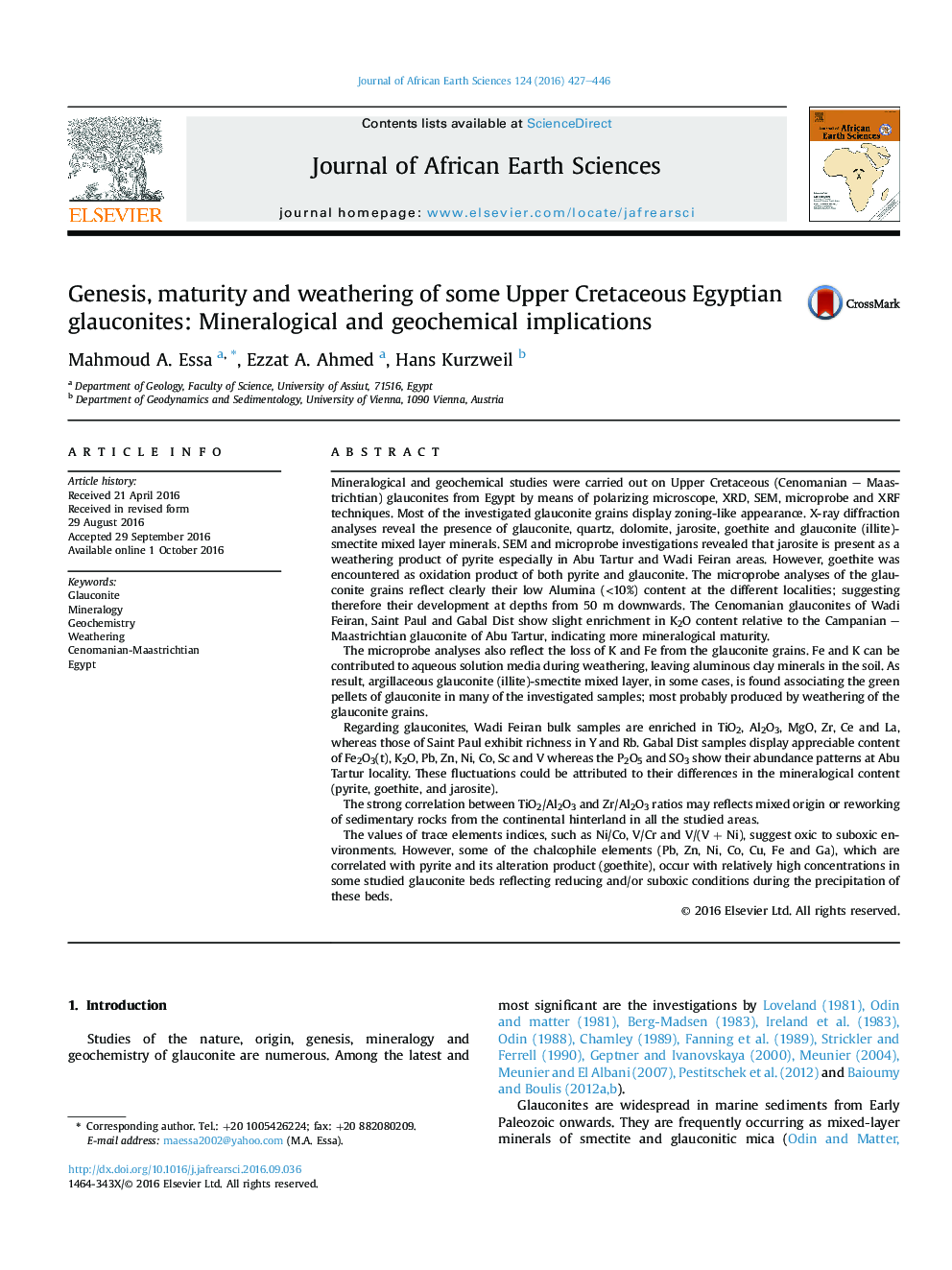| کد مقاله | کد نشریه | سال انتشار | مقاله انگلیسی | نسخه تمام متن |
|---|---|---|---|---|
| 4728158 | 1640184 | 2016 | 20 صفحه PDF | دانلود رایگان |
• Cenomanian glauconies are more mature than the Campanian-Maastrichtian glauconies.
• Muscovite and quartz occur as an important substrate required for glauconitization.
• Most of examined glauconite grains display a zoning due to the weathering effect.
• Glauconite can lose Fe and K during weathering forming illite-smectite mixed layer.
• Jarosite and goethite are present as a weathering product of pyrite and glauconite.
Mineralogical and geochemical studies were carried out on Upper Cretaceous (Cenomanian – Maastrichtian) glauconites from Egypt by means of polarizing microscope, XRD, SEM, microprobe and XRF techniques. Most of the investigated glauconite grains display zoning-like appearance. X-ray diffraction analyses reveal the presence of glauconite, quartz, dolomite, jarosite, goethite and glauconite (illite)-smectite mixed layer minerals. SEM and microprobe investigations revealed that jarosite is present as a weathering product of pyrite especially in Abu Tartur and Wadi Feiran areas. However, goethite was encountered as oxidation product of both pyrite and glauconite. The microprobe analyses of the glauconite grains reflect clearly their low Alumina (<10%) content at the different localities; suggesting therefore their development at depths from 50 m downwards. The Cenomanian glauconites of Wadi Feiran, Saint Paul and Gabal Dist show slight enrichment in K2O content relative to the Campanian – Maastrichtian glauconite of Abu Tartur, indicating more mineralogical maturity.The microprobe analyses also reflect the loss of K and Fe from the glauconite grains. Fe and K can be contributed to aqueous solution media during weathering, leaving aluminous clay minerals in the soil. As result, argillaceous glauconite (illite)-smectite mixed layer, in some cases, is found associating the green pellets of glauconite in many of the investigated samples; most probably produced by weathering of the glauconite grains.Regarding glauconites, Wadi Feiran bulk samples are enriched in TiO2, Al2O3, MgO, Zr, Ce and La, whereas those of Saint Paul exhibit richness in Y and Rb. Gabal Dist samples display appreciable content of Fe2O3(t), K2O, Pb, Zn, Ni, Co, Sc and V whereas the P2O5 and SO3 show their abundance patterns at Abu Tartur locality. These fluctuations could be attributed to their differences in the mineralogical content (pyrite, goethite, and jarosite).The strong correlation between TiO2/Al2O3 and Zr/Al2O3 ratios may reflects mixed origin or reworking of sedimentary rocks from the continental hinterland in all the studied areas.The values of trace elements indices, such as Ni/Co, V/Cr and V/(V + Ni), suggest oxic to suboxic environments. However, some of the chalcophile elements (Pb, Zn, Ni, Co, Cu, Fe and Ga), which are correlated with pyrite and its alteration product (goethite), occur with relatively high concentrations in some studied glauconite beds reflecting reducing and/or suboxic conditions during the precipitation of these beds.
Journal: Journal of African Earth Sciences - Volume 124, December 2016, Pages 427–446
